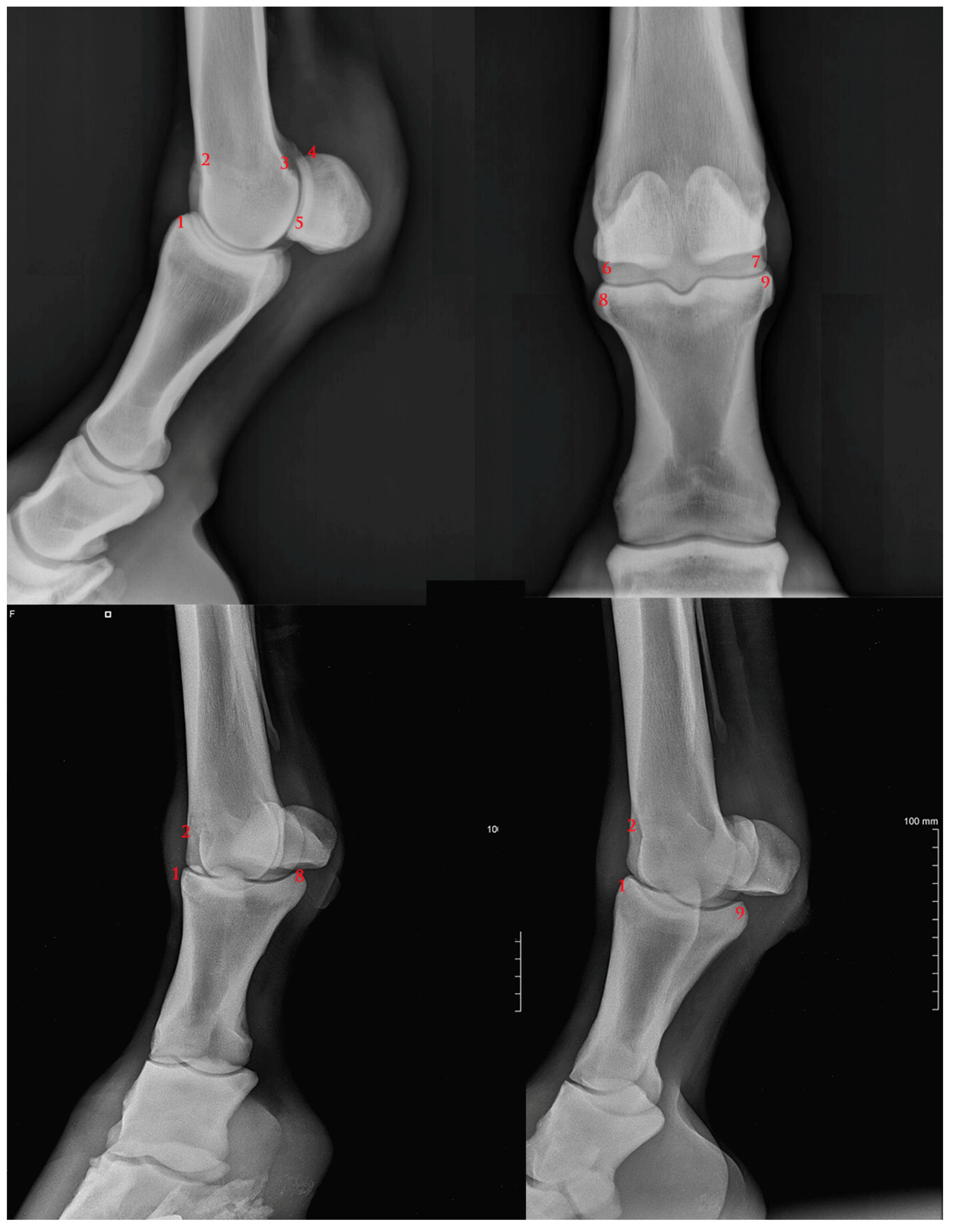Assessment of Intra- and Inter-observer Measurement Variability in a Radiographic Metacarpophalangeal Joint Osteophytosis Scoring System for the Horse
Abstract
:1. Introduction
2. Materials and Methods
2.1. Patient Inclusion Criteria
2.2. MCP Joint Osteophytes Scoring System
2.3. Observers
2.4. Statistical analysis
3. Results
3.1. Population
3.2. Intra-observer Measurements
3.3. Inter-observer Measurement
4. Discussion
5. Conclusions
Author Contributions
Funding
Conflicts of Interest
References
- Thrall, D. Textbook of Veterinary Diagnostic Radiology, 6th ed.; Saunders: Phyladelphia, PA, USA, 2012. [Google Scholar]
- Frisbie, D.D.; Ghivizzani, S.C.; Robbins, P.D.; Evans, C.H.; McIlwraith, C.W. Treatment of experimental equine osteoarthritis by in vivo delivery of the equine interleukin-1 receptor antagonist gene. Gene Ther. 2002, 9, 12–20. [Google Scholar] [CrossRef] [PubMed] [Green Version]
- Frisbie, D.D.; Kawcak, C.E.; Baxter, G.M.; Trotter, G.W.; Powers, B.E.; Lassen, E.D.; McIlwraith, C.W. Effects of 6alpha-methylprednisolone acetate on an equine osteochondral fragment exercise model. Am. J. Vet/Res. 1998, 59, 1619–1628. [Google Scholar]
- Frisbie, D.D.; Kawcak, C.E.; Werpy, N.M.; Park, R.D.; McIlwraith, C.W. Clinical, biochemical, and histologic effects of intra-articular administration of autologous conditioned serum in horses with experimentally induced osteoarthritis. Am. J. Vet. Res. 2007, 68, 290–296. [Google Scholar] [CrossRef] [PubMed] [Green Version]
- Kawcak, C.E.; Frisbie, D.D.; McIlwraith, C.W.; Werpy, N.M.; Park, R.D. Evaluation of avocado and soybean unsaponifiable extracts for treatment of horses with experimentally induced osteoarthritis. Am. J. Vet. Res. 2007, 68, 598–604. [Google Scholar] [CrossRef] [PubMed]
- Kawcak, C.E.; Frisbie, D.D.; Werpy, N.M.; Park, R.D.; McIlwraith, C.W. Effects of exercise vs. experimental osteoarthritis on imaging outcomes. Osteoarthr. Cartil. 2008, 16, 1519–1525. [Google Scholar] [CrossRef] [Green Version]
- Olive, J.; D’Anjou, M.A.; Alexander, K.; Laverty, S.; Theoret, C. Comparison of magnetic resonance imaging, computed tomography, and radiography for assessment of noncartilaginous changes in equine metacarpophalangeal osteoarthritis. Vet. Radiol. Ultrasound 2010, 51, 267–279. [Google Scholar] [CrossRef]
- D’Anjou, M.A.; Moreau, M.; Troncy, E.; Martel-Pelletier, J.; Abram, F.; Raynauld, J.P.; Pelletier, J.P. Osteophytosis, subchondral bone sclerosis, joint effusion and soft tissue thickening in canine experimental stifle osteoarthritis: Comparison between 1.5 T magnetic resonance imaging and computed radiography. Vet. Surg. 2008, 37, 166–177. [Google Scholar] [CrossRef]
- Gunther, K.P.; Sun, Y. Reliability of radiographic assessment in hip and knee osteoarthritis. Osteoarthr. Cartil. 1999, 7, 239–246. [Google Scholar] [CrossRef] [Green Version]
- Innes, J.F.; Costello, M.; Barr, F.J.; Rudorf, H.; Barr, A.R. Radiographic progression of osteoarthritis of the canine stifle joint: A prospective study. Vet. Radiol. Ultrasound 2004, 45, 143–148. [Google Scholar] [CrossRef] [PubMed]
- Rayward, R.M.; Thomson, D.G.; Davies, J.V.; Innes, J.F.; Whitelock, R.G. Progression of osteoarthritis following TPLO surgery: A prospective radiographic study of 40 dogs. J. Small Anim. Pract. 2004, 45, 92–97. [Google Scholar] [CrossRef] [PubMed]
- Roemer, F.W.; Eckstein, F.; Hayashi, D.; Guermazi, A. The role of imaging in osteoarthritis. Best Pract. Res. Clin. Rheumatol. 2014, 28, 31–60. [Google Scholar] [CrossRef] [PubMed]
- Morgan, J.P. Radiological pathology and diagnosis of degenerative joint disease in the stifle joint of the dog. J. Small Anim. Pract. 1969, 10, 541–544. [Google Scholar] [CrossRef] [PubMed]
- Wessely, M.; Bruhschwein, A.; Schnabl-Feichter, E. Evaluation of Intra- and Inter-observer Measurement Variability of a Radiographic Stifle Osteoarthritis Scoring System in Dogs. Vet. Comp. Orthop. Traumatol. 2017, 30, 377–384. [Google Scholar] [CrossRef] [PubMed]
- Junker, S.; Krumbholz, G.; Frommer, K.W.; Rehart, S.; Steinmeyer, J.; Rickert, M.; Schett, G.; Muller-Ladner, U.; Neumann, E. Differentiation of osteophyte types in osteoarthritis—Proposal of a histological classification. Jt. Bone Spine 2016, 83, 63–67. [Google Scholar] [CrossRef] [PubMed]
- van der Kraan, P.M.; van den Berg, W.B. Osteophytes: Relevance and biology. Osteoarthr. Cartil. 2007, 15, 237–244. [Google Scholar] [CrossRef] [PubMed] [Green Version]
- Felson, D.T.; McAlindon, T.E.; Anderson, J.J.; Naimark, A.; Weissman, B.W.; Aliabadi, P.; Evans, S.; Levy, D.; LaValley, M.P. Defining radiographic osteoarthritis for the whole knee. Osteoarthr. Cartil. 1997, 5, 241–250. [Google Scholar] [CrossRef] [Green Version]
- McIlwraith, C.W.; Frisbie, D.D.; Kawcak, C.E.; Fuller, C.J.; Hurtig, M.; Cruz, A. The OARSI histopathology initiative—Recommendations for histological assessments of osteoarthritis in the horse. Osteoarthr. Cartil. 2010, 18 (Suppl. 3), S93–S105. [Google Scholar] [CrossRef] [PubMed] [Green Version]
- Lazar, T.P.; Berry, C.R.; Dehaan, J.J.; Peck, J.N.; Correa, M. Long-term radiographic comparison of tibial plateau leveling osteotomy versus extracapsular stabilization for cranial cruciate ligament rupture in the dog. Vet. Surg. 2005, 34, 133–141. [Google Scholar] [CrossRef] [PubMed]



| Grade | Severity | Findings |
|---|---|---|
| 0 | no osteoarthritis | normal radiographic aspect |
| 1 | mild osteoarthritis | slight osteophytosis and/or slight sclerosis is observed |
| 2 | moderate osteoarthritis | sclerosis and osteophytosis appear moderate |
| 3 | severe osteoarthritis | severe sclerosis and the presence of marked osteophytes |
© 2020 by the authors. Licensee MDPI, Basel, Switzerland. This article is an open access article distributed under the terms and conditions of the Creative Commons Attribution (CC BY) license (http://creativecommons.org/licenses/by/4.0/).
Share and Cite
Lacitignola, L.; Imperante, A.; Staffieri, F.; De Siena, R.; De Luca, P.; Muci, A.; Crovace, A. Assessment of Intra- and Inter-observer Measurement Variability in a Radiographic Metacarpophalangeal Joint Osteophytosis Scoring System for the Horse. Vet. Sci. 2020, 7, 39. https://doi.org/10.3390/vetsci7020039
Lacitignola L, Imperante A, Staffieri F, De Siena R, De Luca P, Muci A, Crovace A. Assessment of Intra- and Inter-observer Measurement Variability in a Radiographic Metacarpophalangeal Joint Osteophytosis Scoring System for the Horse. Veterinary Sciences. 2020; 7(2):39. https://doi.org/10.3390/vetsci7020039
Chicago/Turabian StyleLacitignola, Luca, Annarita Imperante, Francesco Staffieri, Rocco De Siena, Pasquale De Luca, Arianna Muci, and Antonio Crovace. 2020. "Assessment of Intra- and Inter-observer Measurement Variability in a Radiographic Metacarpophalangeal Joint Osteophytosis Scoring System for the Horse" Veterinary Sciences 7, no. 2: 39. https://doi.org/10.3390/vetsci7020039





